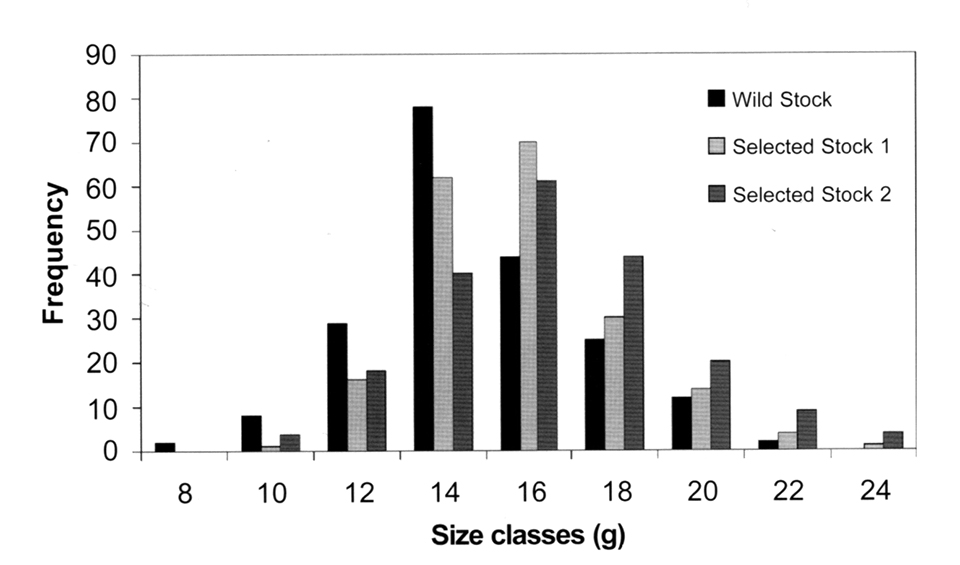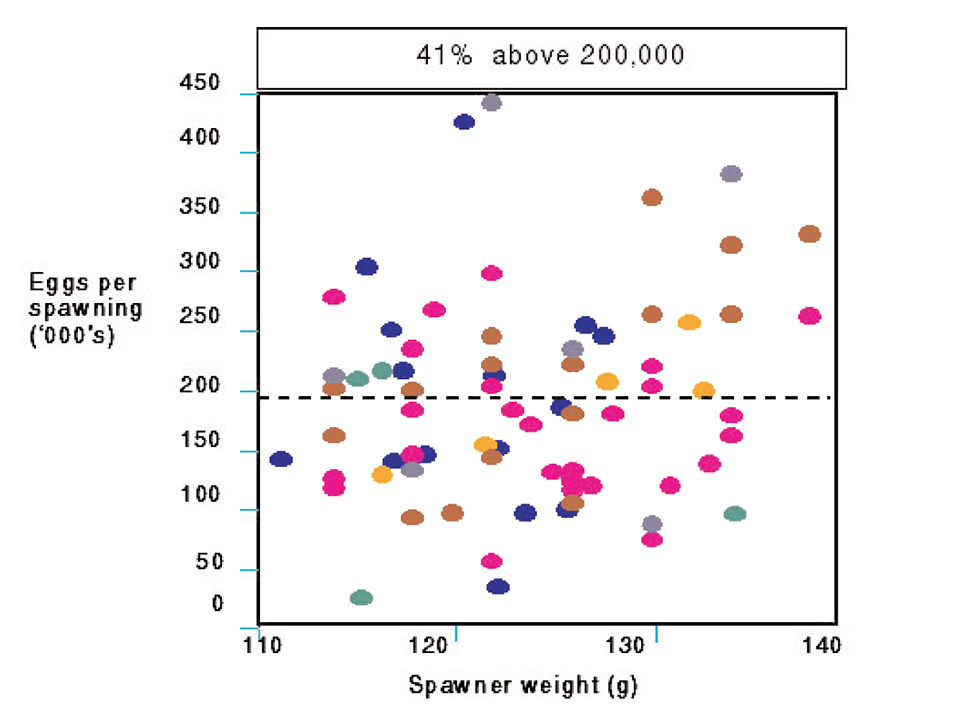CSIRO-industry collaboration results in successful domestication, captive breeding of P. japonicus
The domestication and genetic improvement of farmed prawns has been relatively slow compared to that of some other aquaculture species and most terrestrial livestock. The principal barriers have been the ready availability of wild prawn broodstock and post-larvae, a lack of understanding of prawn reproductive biology and perceptions of low genetic variation among prawns.
The current reliance of the prawn farm industry on wild broodstock is risky, inefficient, and precludes the opportunity to enhance production through selective breeding and controlling the spread of disease. In many countries with substantial prawn farming industries, particularly those in Asia, belated efforts to domesticate broodstock are now hampered by a very high incidence of viral diseases in farm stocks.
In Australia, prawn farming is a relatively new industry. However, recent research advances by the national science agency, CSIRO (Commonwealth Scientific and Industrial Research Organisation), in prawn domestication and selective breeding, coupled with a relatively low incidence of diseases, has placed Australia in a favourable position to make rapid advances in genetic improvement of farmed prawns. In Australia, there is both the need and opportunity to do this with stock that are free of many of the major pathogens responsible for mass mortalities in other prawn farming regions.
The Kuruma prawn – Penaeus japonicus
Progress has been most rapid in the Kuruma prawn (Penaeus japonicus). Farming P. japonicus for live export to Japan is a recent and successful venture in Australia. Commencing in 1991, production doubled each year until 1996 when it reached 190 metric tons valued at $13.4 million. Growth has since slowed, with current production figures of about 200 metric tons valued at $15 million. The profitability of the P. japonicus industry is strongly dependent on production efficiency and export prices.
Over the past six years, collaborative research between CSIRO and industry (Rocky Point Prawn farm P/L and Tomei Australia P/L) has resulted in successful domestication and captive breeding of P. japonicus. Economic analysis has demonstrated that domesticated broodstock are more cost-effective than wild broodstock (Preston et al. 1999). More importantly, improvements in growth rates through selective breeding have been demonstrated in the laboratory and in farm trials with offspring from CSIRO-domesticated broodstock.
Controlled-environment growth experiments in the laboratory to quantify the heritability of growth performance indicated that an 11 percent per generation increase in growth could be achieved by selective breeding (Hetzel et al. 1999). In commercial-scale farm trials in 1998/99, the comparative growth performance of wild and selected stocks demonstrated gains in the weight at first harvest for the selected stocks of 10 to 15 percent (Fig. 1). Due to the increased value of larger size classes in the market, this increased growth resulted in a 21 percent to 34 percent increase in the value per tonne at first harvest. This has given industry the confidence to proceed with collaborative research to further enhance the production efficiency of farmed P. japonicus through genetic improvement.

The ongoing collaborative research combines CSIRO research skills in crustacean biology, quantitative and molecular genetics, virology and food science. The research will progress from an initial transfer of CSIRO domestication technology, through genetic, health and food quality research, and culminate in a structured breeding program. The traits to be included in the breeding program will be based on their relative economic value.
This research program will be one of the first to apply the tools of molecular biology to monitor and quantify genetic and environmental influences on individual families in hatcheries and production ponds. It will also validate and evaluate Economic Trait Loci (ETL) for growth, and develop these into molecular markers to incorporate into the genetic selection strategy. This approach will build on studies carried out between 1993 and 1998, in which CSIRO identified three potential ETL regions in the P. japonicus genome which appear to play a role in determining growth performance (Moore et al. 1999). Knowledge of these ETL regions is so far confined to individual experimental families but there is potential for it to be expanded into direct gene markers as growth predictors for industry application.
The research program will also use advanced (molecular based) health screening techniques to assess and manage broodstock health and provide early warning of known viral pathogens.
In developing on-farm capacity for broodstock domestication, and applying genetic selection in the hatchery and grow-out phases, the research program will reduce industry dependency on wild broodstock. The program will facilitate the use of domesticated, genetically enhanced stocks to improve production efficiency, marketability, and hence profitability.
The Black Tiger prawn – Penaeus monodon
Throughout Asia, and in Australia, the giant tiger prawn (P. monodon) is the dominant prawn species being farmed. Farm production of P. monodon now constitutes about 60 percent of the estimated 700,000 t of total world production of farmed prawns.
The sustainable production of farmed P. monodon in Australia and elsewhere is currently constrained by the unpredictable supply of good quality spawners and postlarvae. This constraint is due principally to the reliance by prawn farmers on wild broodstock. Wild broodstock are highly variable in quantity and quality and do not permit selection for optimal growth and survival in farm conditions. Domestication and genetic improvement are the obvious solutions to reducing the reliance on wild broodstock.
Until recently, progress in the domestication and selective breeding of P. monodon has been relatively slow compared with other species. However, in 1998, in collaboration with an Australian industry partner, Seafarm P/L, CSIRO domestication protocols were successfully applied to P. monodon farm and laboratory stocks.
Progeny from wild broodstock and progeny from pond-reared broodstock were grown to adult size in specialised farm grow-out ponds and in controlled environment tanks. A large proportion of the relatively small P. monodon spawners of 100 to 110 grams grown in tanks and ponds achieved the target reproductive output of 200,000 eggs per spawning (Fig. 2). The results of this trial have clearly demonstrated that the reproductive performance of domesticated P. monodon can match that of wild-broodstock of a similar size.

This trial demonstrated that the reproductive performance of captive stocks is capable of supporting a genetic improvement program. The research priorities are now to further improve the average reproductive output of P. monodon and to commence a program of selective breeding for beneficial traits in this important species.
References
Hetzel, D.J.S., P.J. Crocos, G.P. Davis, S,S. Moore and N. Preston, 1999. Response to selection for growth in the Kuruma prawn, Penaeus japonicus. Aquaculture. In press.
Moore S.S, V. Whan, P.J. Crocos, D.J.S. Hetzel, K. Byrne, G.P. Davis and N. Preston 1999. The development and application of genetic markers for the Kuruma prawn Penaeus japonicus. Aquaculture: 173 19-32
Preston, N.P., D.C. Brennan and P.J. Crocos 1999. Comparative costs of postlarval production from wild or domesticated Penaeus japonicus broodstock. Aquaculture Research, 30: 191-197
(Editor’s Note: This article was originally published in the December 1999 print edition of the Global Aquaculture Advocate.)
Now that you've finished reading the article ...
… we hope you’ll consider supporting our mission to document the evolution of the global aquaculture industry and share our vast network of contributors’ expansive knowledge every week.
By becoming a Global Seafood Alliance member, you’re ensuring that all of the pre-competitive work we do through member benefits, resources and events can continue. Individual membership costs just $50 a year. GSA individual and corporate members receive complimentary access to a series of GOAL virtual events beginning in April. Join now.
Not a GSA member? Join us.
Authors
-
Peter Crocos
CSIRO Marine Research
P.O. Box 120,
Cleveland, Q, 4163, Australia -
Nigel Preston
CSIRO Tropical Agriculture,
Molecular Animal Genetics Centre
University of Queensland,
Brisbane, 4072, Australia -
Sigrid Lehnert
CSIRO Tropical Agriculture,
Molecular Animal Genetics Centre
University of Queensland,
Brisbane, 4072, Australia
Tagged With
Related Posts

Intelligence
Barramundi culture in Australia
From recirculation units, earthen ponds and sea pens in Australia, barramundi are spreading to other continents due to the advent of sophisticated modular culture systems.

Responsibility
Brazil’s inland aquaculture
Freshwater fish culture is practiced in every state in Brazil, primarily at small-scale earthen pond facilities, but tilapia culture in reservoir cages is increasing.

Intelligence
Can shrimp follow the avocado example?
Producers of high-quality, sustainable shrimp have a great story to tell. They just need to come together and shout it out like avocado producers did.

Innovation & Investment
Cooperation grows Australian aquaculture
Expansion of the Bribie Island Research Centre allows agencies to tackle multidisciplinary research tasks to help the Australian aquaculture industry.


